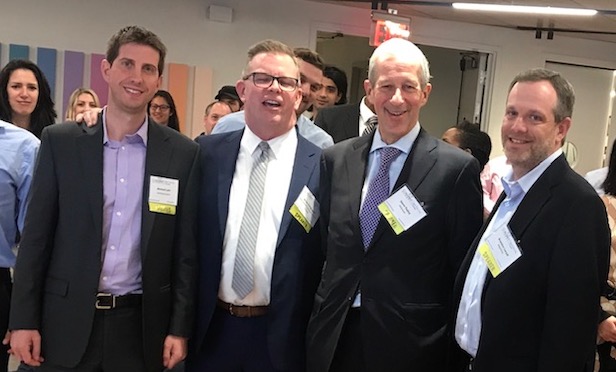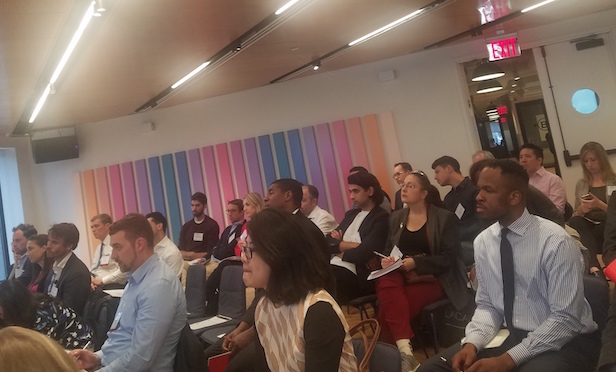 CoreNet New York City Chapter Opportunity Zone event panelists from left: Michael Lohr, Brian Schwagerl, Steve Polivy, Brandon Lacoff
CoreNet New York City Chapter Opportunity Zone event panelists from left: Michael Lohr, Brian Schwagerl, Steve Polivy, Brandon Lacoff
NEW YORK CITY—With the Treasury Department releasing the second tranche of Opportunity Zone guidance in April, what's happening with investments in the tax benefits program?
“We're starting to see momentum. We've got some large checks coming through the door. But it's not going to be easy. Not everybody has capital gain ready to go,” said Brandon Lacoff, founder, CEO and president of private equity investment firm Belpointe. He forecasted increased investment towards the end of the year and even more by 2021 because that's when investors lose 10% of the benefit.
“I think you're going to see the program get more popular in the next two and a half to three years,” he commented. “Then it's going to start dying out slowly because you start losing some of the benefits.”
However, Lacoff also told the audience at the CoreNet New York City chapter's public policy event on Opportunity Zones, that he has also heard rumors about the tax program possibly being extended.
Then, quoting Brett Messing the president of Skybridge, one of his competitors, Lacoff compared Opportunity Zone investing to “high school sex.” “Everybody's talking about it but no one's doing it. It's very early on. We're still in grade school here,” he said.
Steve Polivy, chair of the chief economic development and incentive practice at the law firm Ackerman, explained Opportunity Zones are low-income areas designated by each state, where tax benefits for investments of capital gains would be available. The investments must qualify in terms of types, timing and duration.
Brian Schwagerl, clinical assistant professor at NYU SPS Schack Institute of Real Estate, moderated the discussion. He asked Michael Lohr, VP, Urban Investment Group at Goldman Sachs, how these investments make money?
 Audience at CoreNet New York City chapter public policy event on Opportunity Zones.
Audience at CoreNet New York City chapter public policy event on Opportunity Zones.Lohr explained they are investing capital which is at risk, so any investor or bank who puts money in these projects is expecting a market return. But he emphasized Opportunity Zones investments are different.
“You hear a lot of people in the market saying, 'This is great. I get these tax breaks,'” said Lohr. “But what they don't fully understand is that there is a lot that goes into investing in these communities. There's a reason why they are low income. There are not traditional sources of capital going into those deals.”
Investments can take different forms. In some cases Goldman acts as a straight forward construction lender providing money and charging interest. On the equity side, they partner with developers in mission-oriented projects. They make long-term equity investments, in projects with the goal of creating jobs and boosting economic development in the community. In many cases they pair with federal, state and city subsidy programs. As New York City puts a lot of money in affordable housing, that's a source of capital and Goldman provides another piece.
Lohr pointed out that the New York City Housing Authority has a $30 billion capital problem. The federal government was hoping to provide incentives for the private sector to assist in developing NYCHA markets and projects.
However, he acknowledged there are challenges to figuring out ways to bring capital in and to invest in projects that can make a meaningful, long-term difference in neighborhoods.
Schwagerl asked about the effects of gentrification and how the acceleration of growth can price people out of their neighborhoods. “The very people that you're trying to help get pushed out of the neighborhood. How do these projects address that?”
Lacoff responded that whenever development creates change, someone will be negatively affected. For example, the highway connecting Manhattan to Boston separated communities. “So, change is going to have some negatives. But I think you have to look at the bigger picture and ask, 'Can we do good? Can we help everybody as much as we can?'”
Polivy added in New York City, all development results in displacement. The city has tried to address this with zoning requiring mandatory inclusionary housing.
Instead of freezing development, the panelists recommended working with local stakeholders and the government to incentivize the development where benefits to the community outweigh the detriment.
➤➤ Join the GlobeSt.com ADAPT: Opportunity Zones conference September 16-17 in Baltimore, MD The new national conference series is aimed at identifying Opportunity Zones across all property types and geographic regions. This first-of-its-kind event will educate, connect and celebrate the investors, developers and owners with the people behind the planning and decision-making, such as architects, consultants, academics and, most importantly, municipal officials.
Click here to register and view the agenda.
© Touchpoint Markets, All Rights Reserved. Request academic re-use from www.copyright.com. All other uses, submit a request to [email protected]. For more inforrmation visit Asset & Logo Licensing.







